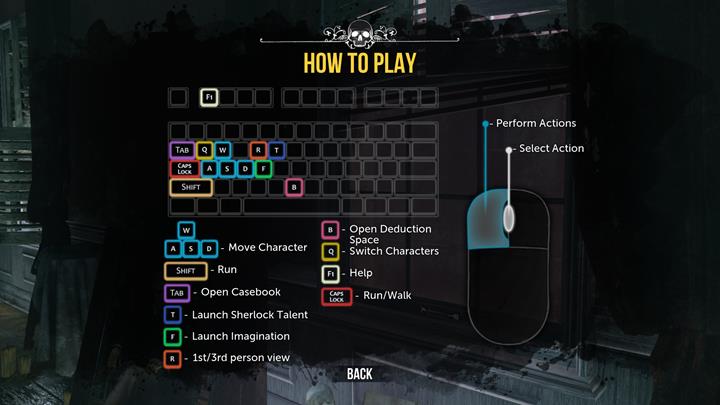Sherlock Holmes The Devil's Daughter: General advices

Controls
Before starting the game you should check controls in the game options menu.
Difficulty level
Two difficulty levels are available in the game. Pick the lower one to avoid most of the riddles and action sequences. The hard mode is more challenging and it contains all the sequences.
Journal
The journal is the most important tool of Sherlock. Inside it you will find detailed description of events, a map with locations to which you can travel, evidence and documents related to the investigation. Additionally, here you can return to dialogues, check character portraits and read letters related to already solved cased.
Evidence
Some evidence will have additional icons. It means that the evidence can be used during a conversation with someone, analyzed or took to the library for further research.
Object interactions
When you press a button in the game, its border should change to green and the zoom should automatically switch back to normal view. If that didn't happen, then the item must be examined more thoroughly - turned around or analyzed in detective mode.
Action sequences and riddles
If you selected easy difficulty, then you can skip most of the riddles. However, this will make it impossible to obtain all achievements in the game. You should remember that exiting the zoom while solving a riddle works like reset - you will start the task from the beginning. It is useful if you feel that you missed something or made a mistake.
Sherlock's special abilities
During the game Sherlock can activate two special vision modes. In detective mode he can notice tracks that no one else sees. In imagination mode Holmes can recreate the events.
Traveling through locations
During the game you must frequently travel through the map. By default Holmes will travel in a stagecoach. While the game loads he can open journal and activate deduction screen. You can turn the interactive journey off in the options and instead have a classic loading screen.
Deduction screen
In deduction screen you can combine evidence and deduce how the case happened. You should combine pairs into evidence earlier, so that there won't be too many of them at the end of the case.
Final deductions
At the end of the case you must select one deduction that will end the case. Usually only one deduction is correct while the rest are incorrect. Frequently you can type many perpetrators and deduce many hypotheses that exclude each other. Don't be afraid to risk and select one option because once the case is over, the game will ask you whether you want to try a different option or accept this deduction as final. You will also verify whether you obtained all the evidence in the case and how many players selected that finale.
Choices at the end of the investigation
Each deduction is related to two evidences. Sometimes you can acquit or convict a person. Sometimes you will participate in QTE sequences which will allow you to shoot someone or capture him. Similarly as in case of deduction, the choices aren't final and you can try various variations.
Markings in the guide
The evidence you can collect are marked with red color, document - blue, arguments in dialogues - green and the more important information is bolded.
You are not permitted to copy any image, text or info from this page. This site is not associated with and/or endorsed by the developers and the publishers. All logos and images are copyrighted by their respective owners.
Copyright © 2000 - 2025 Webedia Polska SA for gamepressure.com, unofficial game guides, walkthroughs, secrets, game tips, maps & strategies for top games.
